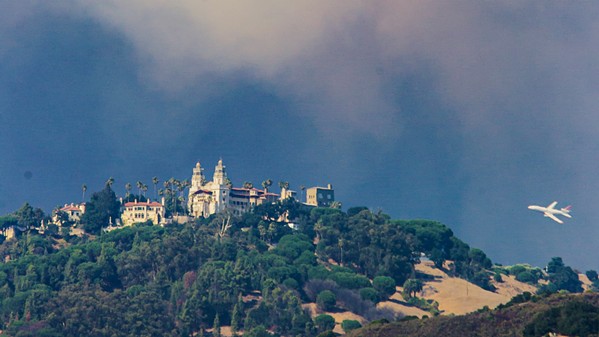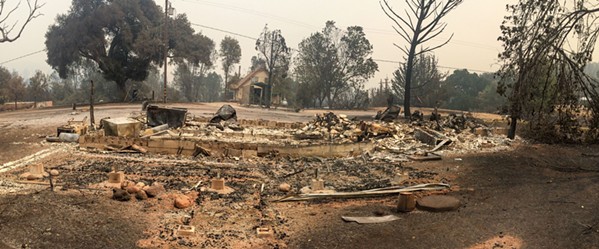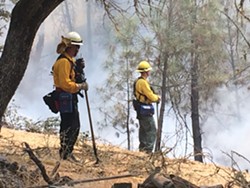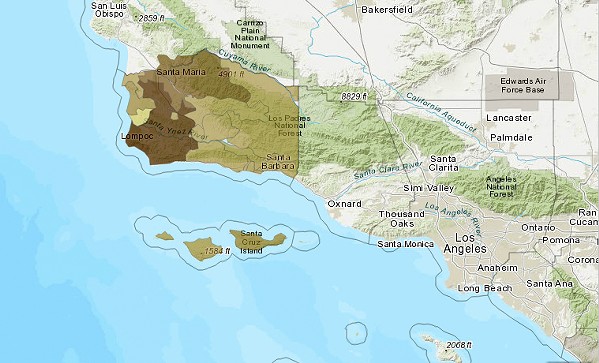Prevention and protection: California and its communities search for ways to combat the next catastrophic wildfire
By New Times Staff[{
"name": "Ad - Medium Rectangle CC01 - 300x250",
"id": "AdMediumRectangleCC01300x250",
"class": "inlineCenter",
"insertPoint": "8",
"component": "2963441",
"requiredCountToDisplay": "12"
},{
"name": "Ad - Medium Rectangle LC01 - 300x250",
"id": "AdMediumRectangleCC01300x250",
"class": "inlineCenter",
"insertPoint": "18",
"component": "2963441",
"requiredCountToDisplay": "22"
},{
"name": "Ad - Medium Rectangle LC09 - 300x250",
"id": "AdMediumRectangleLC09300x250",
"class": "inlineCenter",
"insertPoint": "28",
"component": "3252660",
"requiredCountToDisplay": "32"
}]
Fire seasons in 2017 and 2018 caused the residents of California to take a long, hard look at themselves, their electricity providers, the way their forests are managed, what their evacuation plans look like, and whether their homes are protected.
Communities on the Central Coast face fire yearly, from Lake Nacimiento to the forested hills outside of Santa Barbara. It's just a fact of life. But the questions are: How prepared are we to face the next big one? And what are we doing to protect ourselves?
For this week's cover story, our reporters each took on a piece of that puzzle.
—Camillia Lanham
New laws for a new normal
The hundreds of lives, thousands of homes, and billions of dollars lost in recent catastrophic wildfires like the Thomas Fire in Santa Barbara County and the Camp Fire in the town of Paradise forced state and local leaders to confront tough questions.
In the past year, state legislators adopted a slew of laws aimed at addressing these questions and avoiding the devastation seen the past two years.
"This is life or death," Assemblyman Jordan Cunningham (R-Templeton), who represents San Luis Obispo and Northern Santa Barbara counties, told New Times. "We can't sustain years like 2017 and 2018. There's just no way."
On July 12, Gov. Gavin Newsom signed Assembly Bill 1054. The legislation paves a path forward for the utilities facing billions of dollars in liability for wildfire damages and is seen as an unfortunate but necessary step back to normalcy.
PG&E alone has around $30 billion in liability. In January, the company filed for bankruptcy, and the new law sets a June 2020 deadline for PG&E to complete bankruptcy proceedings. It requires that PG&E get through bankruptcy and make its fire victims whole before it's allowed to participate in a new plan for resolving utility wildfire liability in the future. It's called a wildfire victims' insurance fund, which utilities can dip into for liability costs that exceed their insurance coverage.
There are two options in the legislation for how the fund is structured, and the companies make the choice. The most likely outcome is the creation of a new account with about $21 billion in it. Half of it will be paid by ratepayers, and the other half will be paid by the utilities.
Under this structure, ratepayers wouldn't see an increase in their bills, per se. It extends a $2.50 per month charge that ratepayers have already been paying since the early 2000s, which was set to expire.
The law also forces the power companies to invest $5 billion from shareholder funds into fire hardening their infrastructure, and it requires them to obtain safety certifications from the state on equipment before fire season. Some critics point out, though, that the safety certification will make holding utilities responsible for wildfires more difficult, because it shifts the burden onto victims to show that the utility acted unreasonably.
Cunningham supported AB 1054. He said the law strikes the right balance between protecting fire victims, ratepayers, and utility employees—while also preparing for the future.
"I think it's a good piece of legislation," he said. "It will direct some money into preventing big fires. It protects the ratepayers. It gets money to the fire victims. It protects our employees. And we're doing all that while not raising people's electricity bill."
Senate Bill 901, adopted last summer, sends $1 billion over the next five years to vegetation management activities statewide—which means more controlled burns, forest thinning, and other projects to reduce fire fuels. It also streamlined the process for these projects. Related legislation, Assembly Bill 2551, authorized Cal Fire to help private landowners with prescribed burns.
Cal Fire San Luis Obispo Chief Scott Jalbert said that for decades California had scaled back its vegetation management, which left the state vulnerable as drought and global warming hit.
"The summers are going longer, the temperatures are getting hotter, and we have an abundance of not just fuel, but now we have this abundance of dead fuels," Jalbert said. "As money comes in, we implement the plans to reduce those fuel loads."
The $1 billion funding injection isn't available to local agencies yet, but it will kick in during the 2019-20 fiscal year.
Other state laws focus on fire preparedness. Senate Bill 969 requires all new electric garage doors to include backup batteries so that they open during a power outage. Senate Bill 833 requires the state Office of Emergency Services to develop new statewide protocols for emergency alert systems. Assembly Bill 2911 outlines a variety of new fire safety initiatives, including re-examining building codes, updating fire hazard plans, conducting public information campaigns, and requiring removal of dead or dying trees near transmission lines.
—Peter Johnson
State and local agencies focus on reducing fuel loads
As the number and severity of wildfires throughout California continue to increase, state and local officials are looking toward fuel reduction projects as a possible way to protect communities from these disasters.
After decades of shying away from fuel reduction projects—which generally involve removing trees and shrubs or intentionally burning vegetation in an identified area—the state is making these projects a priority again, said Scott Jalbert, Cal Fire San Luis Obispo unit chief.
"We've woken up," he said. "The state has put $1 billion in five years invested into reducing fuel loads."
In late May this year, Cal Fire awarded Santa Barbara County a grant for $2.2 million to complete fuel reduction projects in Lompoc Valley over the next four years. This was part of $43 million in funding Cal Fire announced that it awarded to 66 local fire prevention projects throughout the state for fiscal year 2018-19.
Similar projects are taking place in Los Padres National Forest as well. Over the last nine months, the U.S. Forest Service announced two large-scale tree removal projects in the Mount Pinos Ranger District.
Forest Service ecologist Nicole Molinari said the forest, which historically used to have very few trees, has grown denser over time. This means that if a fire were to ignite, it would burn much more intensely than previously.
"A fire that used to burn on the surface, that would be fairly easy for a firefighter to put out, now there is so much biomass in the system that it also impedes the ability for firefighters to stop these fires, because they are really raging," Molinari said.
Removing trees from dense areas of forest also potentially reduces the number of trees that could die during a drought because fewer trees will have to compete for water, Molinari said.
The portions of Los Padres National Forest closer to the coast aren't as forested as the Mount Pinos area, so different fuel reduction projects are needed, Molinari said. Projects in the shrublands on the Central Coast usually include prescribed burns and fuel breaks, which are strips of land where shrubs and vegetation are removed to provide firefighters with access to the fire's location.
Jalbert said one reason the state backed away from carrying out prescribed burns and other fuel reduction projects for a while is because of pushback from environmental groups that were concerned about burning vegetation.
"The idea is we don't want to burn it," Jalbert said. "We just want to cut it, chop it, haul it off to the dump. But there's certain areas that's cost prohibitive."
Some conservation groups are also pushing back against tree removal projects taking place in Los Padres National Forest.
Los Padres ForestWatch's conservation director, Bryant Baker, said the projects don't place a limit on the size of trees that can be removed, which means older, larger trees that are more fire resistant can be removed, not just smaller trees.
Additionally, he said he doesn't agree that removing large amounts of trees will actually provide any sort of wildfire relief. According to Baker, removing large trees will increase the amount of wind passing through the forest, which can increase the severity and the amount of area a fire covers.
"So, it may be counterintuitive, but when you have, especially these larger trees, and you have more vegetation in the forests, you can actually buffer against wind effects and heating effects," Baker said.
Despite differences in opinion about what needs to be done, there's an increasing sense of urgency that action must be taken to combat what's becoming a year-round fire season, Cal Fire's Jalbert said.
However, this effort is going to take time.
"Now we've come to a state where we have to do something," Jalbert said. "The thing the public needs to understand is this problem wasn't created overnight. It's going to take decades to fix it."
—Zac Ezzone
First responders expect surge in emergencies during power outages
With California's increasingly hot and dry summer weather, it's becoming all the more likely that electricity could be shut off in huge swaths of the state for days at a time, a daunting reality that first responders and cities on the Central Coast are trying to prepare for.
Utility providers Pacific Gas and Electric Company (PG&E) and Southern California Edison will be administering "public safety power shutoffs" when weather conditions are especially hot, dry, or windy in an attempt to prevent future wildfires like the burns the companies were blamed for in 2017 and 2018.
Customers in high fire-threat areas are more likely to be affected by the outages, but the utility companies say that because energy systems rely on power lines working together across regions, a blackout could impact any of the millions of customers who receive electric service from PG&E and Southern California Edison.
Extended power outages have historically led to tremendous surges in calls for emergency service, according to Daniel Bertucelli, public information officer for the Santa Barbara County Fire Department. That will be especially challenging for local fire departments to handle during the height of fire season, he said, when most resources will be focused on fire suppression and prevention.
"There's only so much we can do," Bertucelli said.
Without electricity, grocery stores and businesses are often forced to close, air conditioning doesn't work, Wi-Fi goes out, cellphones die, traffic signals go down, and people who rely on electric medical equipment—including oxygen pumps and dialysis machines—struggle to adapt. Blackouts lead to more traffic accidents, injuries, and health emergencies, Bertucelli said.
"So we're definitely preparing for it and planning for it and anticipating a significant increase in call volume," he said.
There are more than 1,600 Medicare recipients who are dependent on electricity for medical care in Santa Barbara County, according to the U.S. Department of Health and Human Services. While some of those residents may live in facilities that are required to have standby backup generators, Bertucelli said, many likely live in residential care facilities.
There are roughly 75 residential care facilities in Santa Barbara County without backup generators, he said.
While all hospitals and skilled nursing facilities are required to have standby generators that automatically turn on when electricity is shut off, residential care facilities do not, according to Jan Koegler, manager of Santa Barbara County's Public Health Emergency Preparedness Program.
Residential care facilities are much smaller than hospitals and skilled nursing facilities, Koegler said, and most only have a handful of beds and patients, many of whom might not be reliant on electricity-dependent machines.
Residential care facilities are, however, required to have specific plans for how to address each patient's needs in the event of an outage, and Koegler said planning is something every Californian should be doing right now, regardless of where they live or work. In most emergency situations, she said, simply having a plan is the best way to avoid serious incidents.
Lompoc, which owns its own electric utility but uses PG&E for transmission, is working to inform its residents of the possible public safety power shutoffs through social media and press releases.
At a Lompoc City Council meeting on July 16, Electric Utility Manager Tikan Singh presented on the power shutoffs and a program that would waive backup generators' permitting fees to encourage residents and businesses to install them.
Roy Dugger, an emergency services specialist with the Santa Maria Fire Department, said that while that program probably won't do much to spur generator installations—permit fees are only a little more than $100 while generators that require permits can cost thousands of dollars—residents without generators need to prepare to go without power for days at a time.
First responders will be incredibly busy during the outages, Dugger said. During a power outage a few years ago, he said the Santa Maria police and fire chiefs had to man the dispatch center to help deal with the increase in 911 calls.
"The reality is that we need people to prepare as best as they can because we do not have enough resources to meet everyone's needs," Dugger said. "No organization in the world is that large."
—Kasey Bubnash
Cambria learns that an emergency evacuation could take hours
The community of Cambria faces the very high likelihood of experiencing not just one but multiple wildfires.
That's according to a hazard mitigation plan the Cambria Community Services District, in conjunction with local consultants, created in 2017. While the community has been learning about how to harden its homes against possible wildfire, local agencies are working on a framework for a new emergency evacuation plan.
On June 19, the community was invited to A Wildfire Preparedness Day hosted by the Cambria Fire Safe Focus Group, a hyper-local chapter of the San Luis Obispo County Fire Safe Council. The item that caught everyone's attention was a study completed by Dan Turner from the SLO County Fire Safe Council, Cal Poly professor and transportation engineer Cornelius Nuworsoo, and a partnership with Cal Fire's geographical information systems program. They researched what an evacuation scenario in the Lodge Hill community of Cambria would look like.
If a wildfire were to hit Cambria, it would take the Lodge Hill residents about three hours just to get to Highway 1 and another hour to evacuate to Highway 46. In that specific area, Turner said there's an estimated 2,040 residential and other structures and about 3,992 vehicles. He said to factor in about 700 additional cars on Highway 1.
"The highway's maximum capacity [is] 1,700 vehicles per hour; it can't carry any more," Turner said.
The purpose of the study is to measure everything from land use, to street widths, to number of cars, and the population and use it in specific measured formulaic data, Cambria Fire Chief William Hollingsworth said. That information, he said, gives the department a measured understanding of when Lodge Hill should get evacuated in the event of a wildfire.
"We have an existing evacuation plan now that was developed in connection with Cal Fire a number of years ago. There is a plan on how to facilitate that to the best of everybody's benefit," Hollingsworth said. "However, unless you can look at specific numbers, sometimes it's very difficult to relate that information to people, which is why we wanted to go to this effort of coordinating this with traffic engineers."
While the study only focused on one area, the Cambria Fire Safe Focus Group and county fire council are gearing up to study the rest of the community. Eventually, the department will have enough data to potentially update the current evacuation plan.
Community Services District Board President David Pierson said the study also gives the district the information it needs to potentially ask the county for help.
"The idea of the Fire Safe Focus Group in Cambria is we would then take that information to the county and say, 'Hey, can we get some help here because we've got these long evacuation times?' Maybe there is a way we can build another access road," Pierson said.
Currently, the community has a fire road that goes across Fiscalini Ranch, but the only way in and out is through Highway 1.
The most important information, Pierson said, that a resident could have gotten out of the study was to start thinking about an evacuation plan. He said he and his wife thought about their plan a long time ago.
"We've got two kits, one that's full of things that we need and a second one that we have of clothes. We have a third that's full of files that we'd like to grab. If we have time, we'd like to grab all three of those things and throw them in the back of the car," he said. "If we don't, of course, we just get out." ∆
—Karen Garcia
You can reach any of New Times' intrepid reporters through the editor at [email protected].
Latest in News
Readers also liked…
-

Coast Unified teachers upset over new position's salary and qualifications
Oct 20, 2022 -

SLO police identify alleged driver who hit and killed couple
Dec 22, 2022 -

When the levee breaks: Oceano residents, county officials walk a tightrope of regulations to manage Arroyo Grande Creek, which some say led to the levee's failure in January
May 18, 2023















